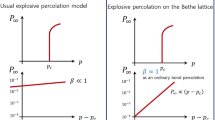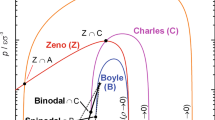Abstract
In the statistical geometry of a hard sphere system of any number of dimensions, V o and S o, the so-called available space and the area of the interface between the available and unavailable space, respectively, can be used as surrogates for chemical potential and pressure. It is shown exactly that, if a first-order transition occurs, the relation dV o/dS o=−σ/2D, where σ is the diameter of a sphere and D is the dimensionality of the system, must hold for densities in the phase coexistence region. This relation is remarkable in that −σ/2D is the ratio of the volume to the surface area of a sphere. Also, it is shown that it is possible for the system to have two successive first-order transitions, but that the occurrence of a continuous transition (even in two dimensions) is unlikely. It is argued that this unlikelihood is substantially strengthened by the absence of temperature (except as a trivial factor) as a variable in hard-sphere systems. This suggests that the findings of the KTHNY theory, recent simulations, and colloid experiments (specialized to “sticky” hard disks) can be extended to true hard disks. The fundamental physics underlying the “magic relation” is yet to be exposed. The author continues to search for the underlying reason and hopes that the present paper will stimulate others to join the search.
Similar content being viewed by others
REFERENCES
It is a pleasure to contribute this paper to the “Festschrift” for Professor George R. Stell whose contributions to fluid theory have been so immense and from whom the author has learned so much.
H. Reiss, J. Phys. Chem. 96:4736 (1992).
B. Widom, J. Chem. Phys. 39:2808 (1963).
B. Widom, J. Phys. Chem. 86:869 (1982).
D. S. Corti, Molec. Phys. 93:417 (1998).
H. Reiss, in Statistical Mechanics and Statistical Methods in Theory and Application, U. Landman, ed. (Plenum, New York, 1977).
R. J. Speedy, J. C. S. Faraday II 73:714 (1977); 75:1643 (1979).
R. J. Speedy, J. C. S. Faraday II 76:693 (1980).
R. J. Speedy, J. Phys. Chem. 92:2016 (1988).
H. Reiss and A. D. Hammerich, J. Phys. Chem. 90:6252 (1986).
H. Reiss, H. L. Frisch, and J. L. Lebowitz, J. Chem. Phys. 31:369 (1959).
H. Reiss and P. Schaaf, J. Chem. Phys. 91:1875 (1989).
H. Reiss and P. Schaaf, J. Chem. Phys. 92:1258 (1990).
R. J. Speedy and H. Reiss, Molec. Phys. 72:999 (1991).
R. J. Speedy and H. Reiss, Molec. Phys. 72:1015 (1991).
H. Reiss, H. M. Ellerby, and J. A. Manzanares, J. Phys. Chem. 100:5970 (1996).
G. Soto-Campos, R. K. Bowles, A. Itkin, and H. Reiss, J. Stat. Phys. 96:111 (1999).
B. J. Alder and T. E. Wainwright, Phys. Rev. 127:359 (1962).
Private communication from F. H. Stillinger.
D. S. Corti and R. K. Bowles, Molec. Phys. 96:1623 (1999).
R. K. Bowles and D. S. Corti, Molec. Phys. 98:429 (2000).
K. Bagchi, H. C. Andersen, and W. Swope, Phys. Rev. Lett. 76:255 (1996).
J. M. Kosterlitz and D. G. Thouless, J. Phys. C. 5:L124, (1972); 6:1181 (1973).
B. I. Halperin and D. R. Nelson, Phys. Rev. Lett. 41:121 (1978).
D. R. Nelson and B. I. Halperin, Phys. Rev. B 19:2457 (1979).
A. P. Young, Phys. Rev. B 19:1855 (1979).
S. T. Chui, Phys. Rev. B 28:178 (1973).
P. Bladon and D. Frenkel, Phys. Rev. Lett. 74:2519 (1995).
H. Weber, D. Marx, and K. Binder, Phys. Rev. B 51:14636 (1995).
K. J. Strandberg, Rev. Mod. Phys. 60:161 (1988).
A. H. Marcus and S. A. Rice, Phys. Rev. E 55:637 (1997).
T. L. Hill, Statistical Mechanics, p. 249 (Dover, New York, 1987).
Private communication from Professor Jerome Percus.
The author is indebted to Professor Stuart Rice for providing him with a preprint of this as yet unpublished work.
S. Sastry, T. M. Truskett, P. G. Debenedetti, S. Torquato, and F. H. Stillinger, Molec. Phys. 95:289 (1998).
P. G. Debenedetti and T. M. Truskett, Fluid Phase Equil. 160:549 (1999).
Author information
Authors and Affiliations
Rights and permissions
About this article
Cite this article
Reiss, H. “Magic Relation” Between the Structures of Coexisting Phases at a First-Order Phase Transition in a Hard Sphere System. Journal of Statistical Physics 100, 73–87 (2000). https://doi.org/10.1023/A:1018627325705
Issue Date:
DOI: https://doi.org/10.1023/A:1018627325705




